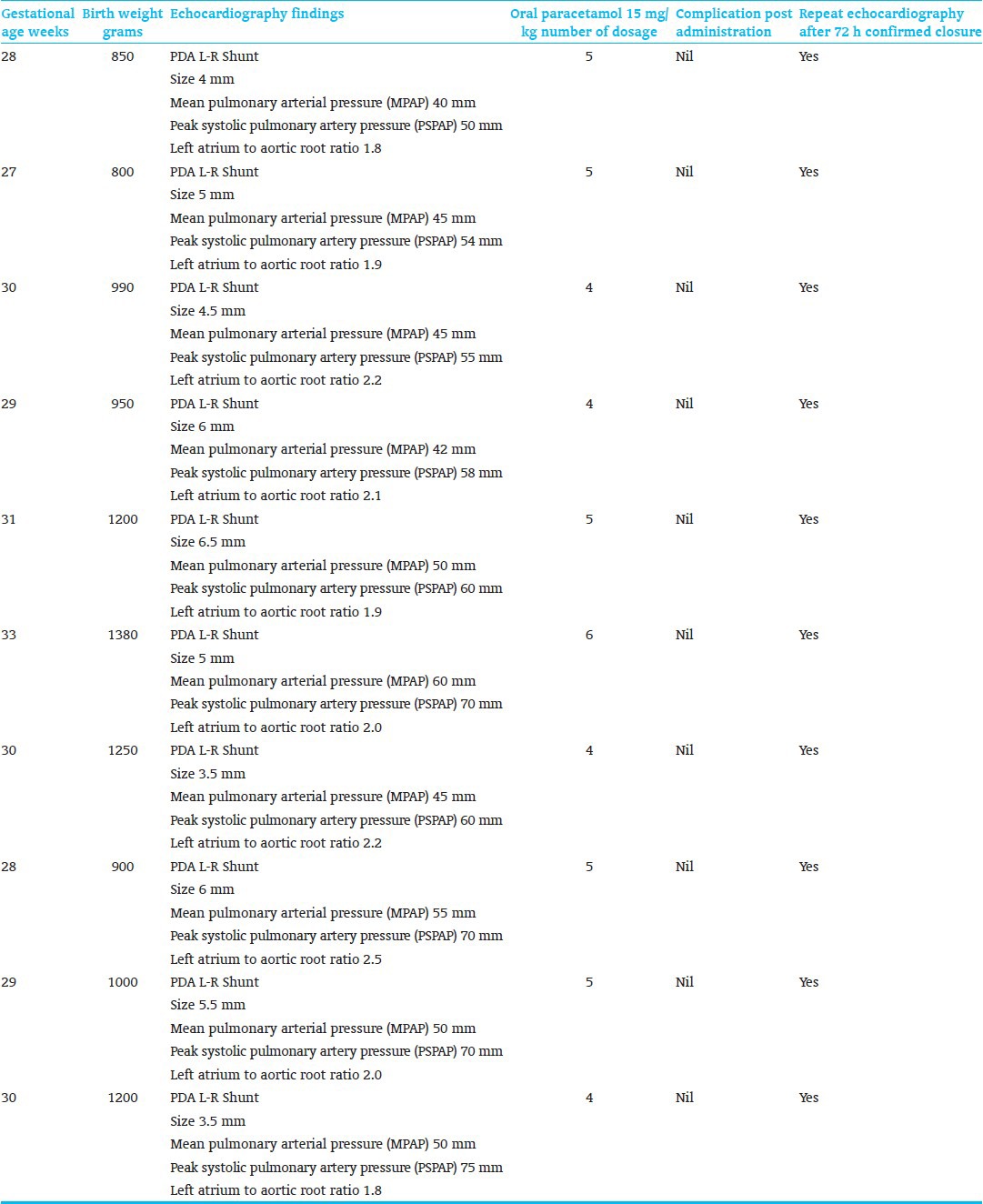Abstract
Patent ductus arteriosus (PDA), in which there is a persistent communication between the descending thoracic aorta and the pulmonary artery that results from failure of normal physiologic closure of the fetal ductus, is one of the more common congenital heart defects in preterm neonates. The closure of PDA can be done with either Indomethacin or Brufen which are cyclooxygenase 1, 2 inhibitor; however these drugs are associated with side effects. We report an interesting findings of ductal closure in 10 preterm neonates (gestational age 27-33 wks) presenting with significant large PDA who had failed or had absolute contraindication with Brufen. These preterm neonates were treated with oral paracetamol in the dose of 15 mg/kg 8 hourly. The PDA closure was achieved within 48 h and there was no complication.
Keywords: Ductus, paracetamol, brufen, preterm
INTRODUCTION
It was observational study for six months from November 2011 to April 2012. There were total of 96 NICU admissions. An ethical committee consent was taken to use oral paracetamol for patent ductus closure in preterm neonates with significant PDA who had contraindication for Brufen/Indomethacin use.[1] Also the parental consent was taken before the study. There were total of 18 preterm neonates who had significant PDA, out of these oral Brufen was given to eight preterm neonates and 10 were given oral Paracetamol as Brufen was contraindicated. We report 10 preterm neonates born at gestational age 27-33 weeks with birth weight range 800 grams to 1,400 grams admitted to our NICU. All these preterm neonates were diagnosed to have hemodynamically significant (features of congestive cardiac failure) PDA at 4-7 days of life. All these neonates had contraindication to Brufen/Indomethacin for ductal closure. Each of these neonates were given oral paracetamol in the dosage of 15 mg/kg 8 hourly for 48 h. These neonates were monitored for temperature changes before and 30 min after giving oral paracetamol and no significant temperature difference was noted. The ductal closure was achieved in all neonates by 48 h of administration. The ductal closure was confirmed with repeat echocardiography after 72 h of administration of oral paracetamol. These neonates did not suffer any complication related to paracetamol.
RESULTS
The results are referred in Table 1.
Table 1.
Gestational age, weight, paracetamol dosage and echocardiographic findings

DISCUSSION
Approximately, 70-80% of preterm neonates require pharmacologic and/or surgical intervention to close a hemodynamically significant patent ductus arteriosus (PDA). Indomethacin has been the pharmacologic treatment of choice and has also been used prophylactically in very premature neonates to prevent PDA.[2,3] The drug, however, is associated with renal and gastrointestinal adverse effects. In July 2006, intravenous ibuprofen became available in the United States for treatment of hemodynamically significant PDA. The mechanism of action for both indomethacin and ibuprofen is through inhibition of prostaglandin synthesis, resulting in ductal constriction. Both drugs appear to be equally efficacious in closing echocardiographically confirmed PDA. Ibuprofen has demonstrated significantly less effects on cerebral, renal, and mesenteric blood flow in premature neonates when compared with indomethacin.[4,5] A transient but significant increase in serum creatinine concentration, decrease in urine output, and increase in frequency of oliguria were observed with indomethacin when compared with ibuprofen. However, the rate of reopening of the ductus after pharmacologic closure and the need for rescue therapy were not different between the two drugs. In addition, no differences were noted in other outcomes such as frequency of intraventricular hemorrhage, necrotizing enterocolitis, or chronic lung disease, as well as in duration of mechanical ventilation and length of hospital stay.[4,5]
The paracetamol also inhibits prostaglandin synthetase activity. Although its precise mechanism of action remains controversial, Paracetamol seems to act at the peroxidase segment of the enzyme. Peroxidase is activated at 10-fold-lower peroxide concentrations than is cyclooxygenase.[6,7] Therefore, paracetamol-mediated inhibition is facilitated at reduced local peroxide concentrations (e.g., hypoxia). Theoretically, these differences would permit peroxidase inhibition to be optimally effective under conditions in which cyclooxygenase inhibition is less active or hypothetically, render it ideally suited for treatment in the PDA environment. The exact mechanism use of oral paracetamol in ductal closure has not been studied on large scale; however with this study it is evident that oral paracetamol is equally effective in ductal closure with no side effects which was there with Brufen/Indomethacin. However, a large randomized study is needed to validate this interesting observation.
Footnotes
Source of Support: Nil
Conflict of Interest: None declared.
REFERENCES
- 1.Hammerman C, Bin-Nun A, Markovitch E, Schimmel MS, Kaplan M, Fink D. Ductal closure with paracetamol: A surprising new approach to patent ductus arteriosus treatment. Pediatrics. 2011;128:e1618–21. doi: 10.1542/peds.2011-0359. [DOI] [PubMed] [Google Scholar]
- 2.Vanhaesebrouck S, Zonnenberg I, Vandervoort P, Bruneel E, Van Hoestenberghe MR, Theyskens C. Conservative treatment for patent ductus arteriosus in the preterm. Arch Dis Child Fetal Neonatal Ed. 2007;92:F244–7. doi: 10.1136/adc.2006.104596. [DOI] [PMC free article] [PubMed] [Google Scholar]
- 3.Sekar KC, Corff KE. Treatment of patent ductus arteriosus: Indomethacin or ibuprofen? J Perinatol. 2008;28:S60–2. doi: 10.1038/jp.2008.52. [DOI] [PubMed] [Google Scholar]
- 4.Shah SS, Ohlsson A. Ibuprofen for the prevention of patent ductus arteriosus in preterm and/or low birth weight infants. Cochrane Database Syst Rev. 2006;1:CD004213. doi: 10.1002/14651858.CD004213.pub2. [DOI] [PubMed] [Google Scholar]
- 5.Jones LJ, Craven PD, Attia J, Thakkinstian A, Wright I. Network meta-analysis of indomethacin versus ibuprofen versus placebo for PDA in preterm infants. Arch Dis Child Fetal Neonatal Ed. 2011;96:F45–52. doi: 10.1136/adc.2009.168682. [DOI] [PubMed] [Google Scholar]
- 6.Grèen K, Drvota V, Vesterqvist O. Pronounced reduction of in vivo prostacyclin synthesis in humans by paracetamol. Prostaglandins. 1989;37:311–5. doi: 10.1016/0090-6980(89)90001-4. [DOI] [PubMed] [Google Scholar]
- 7.Lucas R, Warner TD, Vojnovic I, Mitchell JA. Cellular mechanisms of acetaminophen: Role of cyclo-oxygenase. FASEB J. 2005;19:635–7. doi: 10.1096/fj.04-2437fje. [DOI] [PubMed] [Google Scholar]


